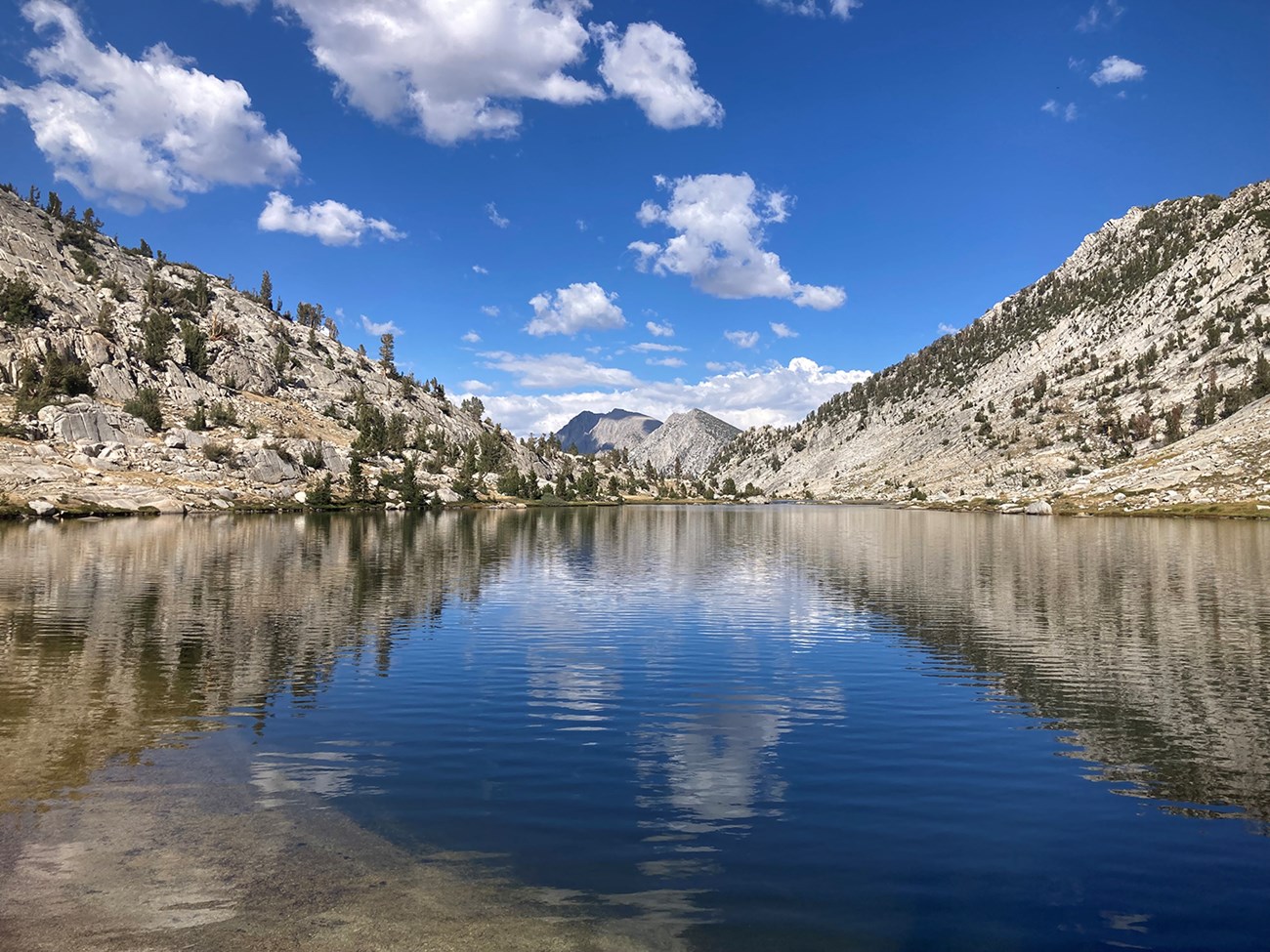Last updated: November 16, 2023
Article
Assessing Nitrogen in Sierra Nevada Lakes

NPS/Emma Kahle
The clear blue waters of Sierra Nevada lakes are featured in many photos of wilderness hikes and camping trips. In addition to their beauty, these lakes provide habitats for native animals, such as Sierra yellow-legged frogs, aquatic invertebrates, and terrestrial animals that feed on lake-dwelling organisms. Even though many of these lakes are in remote wilderness locations, air pollution can cross park boundaries and affect the lakes’ water quality. This article summarizes the study “Nitrogen assessment points: development and application to high-elevation lakes in the Sierra Nevada, California” by Heard et al. (2016), in which researchers attempted to understand the effects of nitrogen on Sierra Nevada lakes.
Why is nitrogen important?
Lakes in the Sierra Nevada mountains occur in rocky basins that generally have low amounts of nutrients. Plants and animals that live in these lakes are accustomed to these low nutrient levels. However, communities upwind of the mountains generate pollution that travels on air currents, and precipitation deposits this pollution into Sierra Nevada lakes, increasing the amount of nutrients in the water (Fig. 1) . Nitrogen is one of these nutrients.
The low amounts of nutrients in Sierra Nevada lakes have led these lakes to evolve with nitrogen as a limiting nutrient, meaning that the amount of nitrogen present is one of the factors that can limit the growth of algae and other organisms. An increase in nitrogen can lead to an increase in the growth and abundance of organisms like algae (small green aquatic plants), which upsets the balance of these ecosystems. For example, when large amounts of algae die and decay, this process can reduce the amount of dissolved oxygen in the water, making survival difficult for animals.

NPS / Michael Warner
To determine how nitrogen levels are affecting lake water quality, Sierra Nevada Network Physical Scientist Andi Heard and James Sickman, Professor of Hydrology from the University of California, Riverside, developed nitrogen “assessment points,” which they used to evaluate lakes across Sequoia, Kings Canyon, and Yosemite national parks.
What are “assessment points”?
Assessment points are pre-selected values that trigger the assessment of a resource relative to management goals, natural variation, or potential concerns, like human or ecological health. For this study, the researchers assessed water quality relative to the ecological health of Sierra Nevada’s sensitive lake ecosystems.
How were assessment points developed?
In order to understand and quantify the response of algae to increased lake nitrogen, the researchers conducted experiments in several Sierra Nevada lakes. They put large containers filled with lake water into the middle of the lakes. The water in the containers did not mix with the surrounding lake water, so the researchers were able to manipulate and monitor the lake chemistry within the containers. They added different levels of nitrogen to the containers and measured both the nutrient concentrations and the algal response over time.
The relationships they found between the nitrogen concentrations and the algal nutrient uptake and growth allowed the researchers to calculate assessment points. They calculated 10%, 50%, and 90% assessment points for nitrogen in relation to algal response levels: 10% indicates that algal growth is present, 50% indicates a level where rapid algal growth is likely to occur, and 90% indicates the level where nitrogen is no longer the growth-limiting nutrient in the system.
The researchers calculated assessment points for early in the hydrologic season, when snowmelt and the resulting runoff have a strong influence on lake processes, and for late in the season, when runoff has less influence on lake processes. They found that the 10%, 50%, and 90% doses occurred at relatively low concentrations of nitrogen (ranging from 0.33 to 18 μmol/ liter) (Table 1).
| 30% Dose µmol/L | 20% Dose µmol/L | 10% Dose µmol/L | Season |
|---|---|---|---|
| 18 | 4.0 | 0.89 | Early |
| 3.1 | 1.0 | 0.33 | Late |
How are assessment points useful?
The researchers compared data from 75 lakes against the 10%, 50%, and 90% assessment points for both early and late season time periods (Fig. 2). 28–37% of lakes exceeded the 10% threshold that indicates an early warning of initial change, and up to 21% of lakes exceeded the 90% threshold that indicates nitrogen is no longer the nutrient limiting growth. The researchers are most concerned with this 10% assessment point. These experiments helped the researchers learn the amount of nitrogen a lake needs to reach this early warning point. This knowledge is helpful because at this early point, people still have time to protect these lakes from exceeding the amount of nitrogen suitable for a healthy ecosystem.

NPS / Andi Heard
Which lakes are most sensitive to nitrogen?
The most sensitive lakes, and, therefore, the lakes most likely to exceed the assessment points, are located at higher elevations and in rocky, steep watersheds. These areas tend to have few plants growing. Plants take up and store nitrogen and also slow nitrogen’s flow downslope, reducing the amount of nitrogen that reaches streams and lakes. Without vegetation, these high-elevation lakes and lakes in steep areas are most vulnerable to nitrogen accumulation.
Why does nitrogen in Sierra Nevada lakes matter?
An increase in the amount of nitrogen in an ecosystem indicates a significant ecological change. This change affects the ecosystem’s productivity and affects the number and type of organisms that are able to live there. The development of nitrogen assessment points allows managers and policy makers to make informed decisions about protecting Sierra Nevada lakes.
